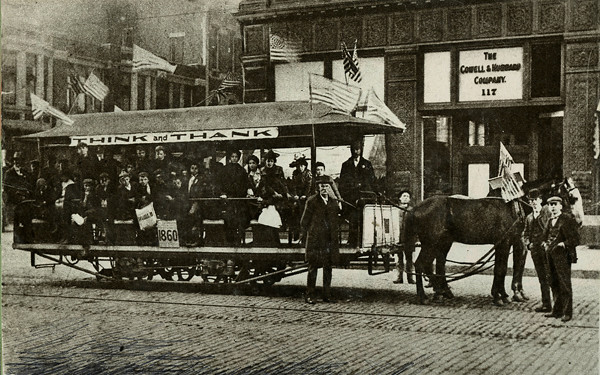Bucklin’s Hospital & Camp: “The Awful Tide Upon Us” (Part 11)
 In Hospital and Camp, A Woman’s Record of Thrilling Incidents Among the Wounded in the Late War by Sophronia E. Bucklin
In Hospital and Camp, A Woman’s Record of Thrilling Incidents Among the Wounded in the Late War by Sophronia E. Bucklin
It’s Week 10 of our read-along with extra historical notes and images. If you want to catch up on the chapter notes, just click here for the collection in the archive. This week we are looking at chapters 21 and 22.
Chapter 21
Spring in 1864 did not look like other springs in parts of Maryland, Virginia, and Washington City. Particularly by this year of the Civil War, notable environmental changes scarred the landscape – the results of thousands of men and animals living and fighting over a the region. The previous year soldiers noted that the grass did not grow in some places due to the constant trampling of boots and hoofs. Nurse Bucklin’s observations may have been clouded by a feeling of gloom, but she observed the changes to the landscape around the hospital from the grasses to the flowering trees.
Consumption was one of the 19th Century names for tuberculosis. No successful treatments could ease the lung disease for the patients, and by the time a sufferer reached the condition of the soldier Bucklin was treating, palliative care was the only option.
The consumptive soldier’s wife came to stay with him, but one of the surgeons made inappropriate remarks to her—probably asking her to be his mistress from the semi-veiled language Bucklin used. The woman refused, stating that she would be faithful to her husband, and the surgeon proceeded to make her life miserable with further harassment. Finally, Bucklin helped the woman make an escape, sorrowfully forced from her dying husband’s bedside. Then, the disreputable surgeon turned his harassment to Nurse Bucklin. She appealed to Dorothea Dix who helped strategize an escape. In the end, the surgeon was charged with misconduct, sent to Old Capital Prison, stood court-marshal, and was dismissed in disgrace from the military.
After that eventful and troubling incident which removed Bucklin from Camp Stoneman (much to the distress of her patients and the friendly medical staff), she did a little shopping and rested, getting ready for her next assignment. “I took the streetcars for Georgetown” she recalled. Streetcars? Yes! The first very streetcar lines opened in New York City in 1832, and by the Civil War era, the national capital had modernized too. The cars usually ran on light rails and were pulled by mules. For a fee, passengers could board the typically open sided cars and be taken to their next destination.

Nurse Bucklin’s new assignment was with the Army of the Potomac—in the field. Journeying there involved a boat ride on a crowded vessel with soldiers and officers. Before long, Bucklin discovered she did not want to join the navy or take a pleasure cruise; violently seasick and with effects lasting days, she managed to disembark at White House Landing on the banks of the Pamunky River.
Chapter 22
She said she arrived at White House Landing a day or two before the Battle of Cold Harbor—early June. After working through the chaos and crowds at the landing (and still seasick), Bucklin and another government nurse got some assistance and direction to their new hospital site for the II Corps which was literally in a field about a mile and a half from the river “port.” A helpful soldier assisted the ladies by putting up a tent for shelter and privacy and also found them clean blankets. It took days for the government nurses’ supplies to arrive.

Thankfully, Mrs. Brainard—a Sanitary Commission agent for the state of Michigan—had worked with Bucklin at Gettysburg and came to the ladies’ aid, letting them join the dining mess until the supplies arrived. Bucklin repaid the kindness when her rations finally arrived, taking her extra portion to the civilians.
Need an 1864 weather report for the time around the Battle of Cold Harbor? Bucklin has the details:
We were waiting for our work during those bright arid warm June days, when the genial sun shone tenderly upon the tall grass—the little roots of which seemed to be affording ample nourishment to the graceful leaves, The days were warm—at times, quite so—while the nights were cold and raw. The transition from sultry afternoons to nights of November chilliness was so rapid that we could scarcely realize it. We suffered from the heat and cold alternately through the twenty-four hours.
When the casualties arrived from the Battle of Cold Harbor, the II Corps hospital did not have enough tents or makeshift shelters to get the wounded under cover. Nurse Bucklin graphic described the open field of badly wounded soldiers and how she and the other nurses when directly to the injured and started cleaning and dressing wounds which was likely the first medical attention for many of these wounded. The number of mortally wounded soldiers seemed to shock Bucklin, even after her Gettysburg experiences: The dead lay by the living; the dying groaned by the dead,‘and still one hundred ambulances poured the awful tide in upon us.
With almost two weeks left in the Overland Campaign and then the fighting around Petersburg still to come in the year, Bucklin’s time in the field as an army nurse would continue to be tragically eventful.
To be continued next weekend…